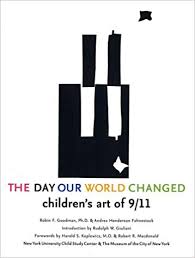Children’s Books in the Aftermath of 9/11
Listen to the Recess! Clip
| Author | John Cech (read by Fiona Barnes) |
| Air Date | 9/12/2002 |

Children’s Books in the Aftermath of 9/11 Transcript
Since last September 11th, children’s books have been very quiet about this difficult subject. In many ways, writers, artists, editors, and publishers are still trying to figure out what to say, and in what forms to say it — picture books, novels, or non-fiction. At least one picture book about a trip to New York City, published before last fall, has been reissued in a revised edition, without images of the Trade Towers.
A few new books for young people — like James Rumford’s Travelling Man, The Journey of Ibn Battuta, about a 14th-century Moroccan explorer, and Naiomi Shihab (“Sheehab”) Nye’s 19 Varieties of Gaselle: Poems of the Middle East, a moving collection of verse by an Award-winning Palestinian-American writer — offer some historical and poetic insights into Middle Eastern culture. More of these books are sure to appear in time.
We have, however, seen an outpouring of books about America — from real stories about, say, the origin of the song, America the Beautiful, to fantastic tales, like Michael Garland’s spoof on President Taft and his enormous appetite in The President and Mom’s Apple Pie. These books would have been in process well before the events of last September, and their synchronistic arrival now is especially appropriate. A recent picture book by Louise Borden, America Is, mixes historical and geographic facts with art to create an ode to this diverse country. Lynne Cheney’s America, A Patriotic Primer, illustrated by Robin Preiss (“Price”) Glasser, takes the reader on a journey through American history, presented as an alphabet book and loaded with detail but without losing a sense of play: children are jumping rope beneath the federal columns that frame the letter “C.” There is a spirited, witty intepretation of the Preamble to the Constitution of the United States, told from a child’s point of view in David Catrow’s We the Kids. And if you want to hone your family’s knowledge even further, you can take Brain Quest America along on your next car trip, and while you’re driving past Plymouth on Rt. 3, see who can answer this question: “About how many passengers sailed to America on the Mayflower?”
Explore This Topic Further
Since these programs are produced well in advance of the actual days on which they air, we sometimes hear about things after it is possible to include them in our shows. After we had already finished the programs about children’s books, we learned of this volume:
911: The Book of Help. Edited by Michael Cart with Marc Aronson and Marianne Carus. Chicago: Cricket Books, 2002.
Here is a brief description from the press release: “911: The Book of Help is a joint effort of more than 25 award-winning authors and a Caldecott honor-winning illustrator to respond to the tragedy. A portion of the proceeds will be donated to the Families of Freedom Scholarship Fund. The poems, stories, essays, and art express emotions ranging from fear, shock and rage, to prayers for healiing and dreams of peace.”
The volume includes works by Katherine Paterson, Kyoko Mori, Russell Freedman, Susan Cooper, Jim Murphy, Sonia Sones, Walter Dean Myers, and Suzanne Fisher Staples.
You may also be interested in:
The Day our World Changed: Children’s Art of 9/11. New York: Abrams, 2002.
This volume is a combined effort by the New York University Child Study Center and the Museum of the City of New York. Steven Heller writes about the book in The New York Times Book Review ( 8 September 2002, p.11):
“The drawings, paintings and collages were done by students from New York, Connecticut and New Jersey, between the ages of 5 and 18, and chosen by a jury of art curators, educators and a child psychologist. . . . Many of the works reveal the naivete of their young creators, but some, like the nighttime cityscape of the Brooklyn Bridge and Twin Towers from across the East River by 8-year-old Yvette Miller, display so much emotional exuberance that they belie the artist’s ages.”